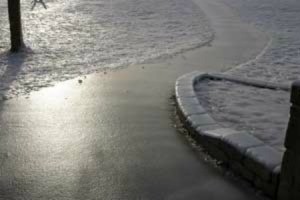 Winter weather can quickly make sidewalks and footpaths difficult and dangerous for pedestrians to navigate. Over the years, several effective and economical deicing products have been developed to give us a safer foothold. Once the ice melts, however, these products can end up damaging our lawns and polluting our waterways.
Winter weather can quickly make sidewalks and footpaths difficult and dangerous for pedestrians to navigate. Over the years, several effective and economical deicing products have been developed to give us a safer foothold. Once the ice melts, however, these products can end up damaging our lawns and polluting our waterways.
Cons: CaC12 attracts moisture from the air so it can leave behind a slippery residue that can be harmful to carpet, tile, shoes and your pet's feet. It can also be corrosive to metal.
Cost: About three times more expensive than rock salt, but you only need to use 1/3 as much it.
Cons: It draws heat from the environment rather than releasing it, so it is not very effective below 25º F. Salts can leach into soil, changing its chemical composition and eventually flowing into local waterways. Salt is also highly corrosive to paved surfaces, buildings and metal.
Cost: Rock salt is generally the least expensive deicing product.
Cons: It only works to 25º F. It can sometimes dilute and refreeze, leaving a slick residue on walkways.
Cost: About twenty times more than regular rock salt.
Cons: Increased potential to burn foliage and inhibit rooting of plants due to its high salt content. Performs poorly below 20º F.
Cost: Costs three to five times as much as sodium chloride, but doesn't work as well at low temperatures, so you need up to ten times as much to be effective.
Cons: Performs poorly below 20º F. It still has the potential to burn your lawn, shrubs and other plants when the chemicals dissolve ice and collect in one area. Very little of most fertilizer-based deicers are actually beneficial to your lawn. Most of the nutrients end up running off frozen soil in the spring and flowing into storm drains, where they cause massive algae blooms in local waterways.
Cost: Varies, but generally inexpensive.
Cons: It attracts moisture from the air so it may keep pavement wet, leaving a slick residue. It also lowers oxygen levels in waterways if allowed to enter storm drains and is not always readily available to the public.
Cost: Eight times more than rock salt.
Cons: Is corrosive and attracts moisture from the air, which can keep pavement wet.
Cost: Two times more costly than rock salt, and you also need twice as much of the product for effective results.
Cons: Both products are considered by the EPA to be highly toxic to aquatic organisms.
Cost: Three to four times the cost of rock salt.
Cons: Dry sand does not readily "stick" to ice or cause it to melt effectively. It may need to be dampened before application. If not cleaned up promptly in the spring, sand can clog storm drains and transport absorbed contaminants into local waterways.
Cost: Three to four times more costly than rock salt.
This page contains the following solutions.
Epsom salts and sugar, mixed 1 to 1, will melt salt and ice. It does not hurt the plants or ground,nor will it hurt birds, dogs, or cats. It can be used to pre-treat sidewalks and driveways and roads.
My husband uses one of my empty plastic flower pots to spread salt on the icy sidewalk. The drainage holes are just the right size to let out the salt as he shakes the pot over the ice.
If you need to salt your driveway or stairs, try this. My salt from last winter absorbed some moisture during the fall, and the salt bucket had as much water in it as salt. I scooped up a bunch of both and spread it out and had great results!
Winter is here and it seems like we constantly have to put down salt on either the driveway or the sidewalk. So my husband, being the clever person he is, came up with a very easy and cost effective way to put down our salt. He uses our hand crank seed thrower.
Another use for Folger's handled coffee container is filling it with sidewalk safety salt or calcium chloride pellets during winter. The handle makes it safe and easy to dispense the product as needed.
Here are the questions asked by community members. Read on to see the answers provided by the ThriftyFun community.
What are some home remedies I can use to keep my sidewalk thawed? Please, does anyone know of any?
Rock salt is the best. Then sprinkle cat litter (inexpensive like 4.5 lbs for 1.00 at the Dollar Tree) to keep it safer. Hope that helps.
Has anyone tried adding water to hardened ice melt and spraying it? I'm thinking of giving it a try as completely breaking it up is a lot of work. I just don't know if there is any chemical reaction when adding water to potassium chloride.
This is a page about keeping ice off steps and walkways. Icy steps and walkways can be very hazardous.
Rock salt can be used more than just one time! When it has done it job, just sweep it up and save for next snow fall.